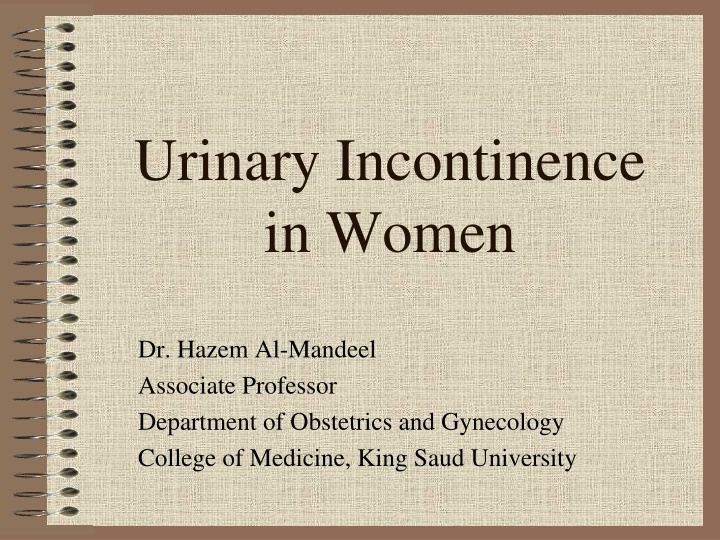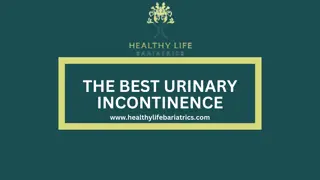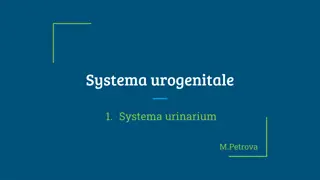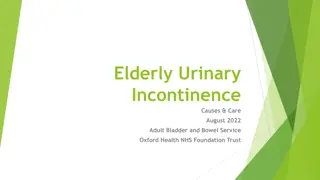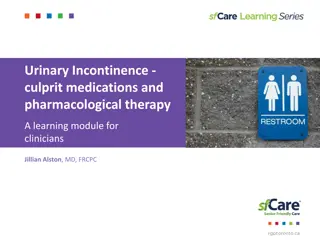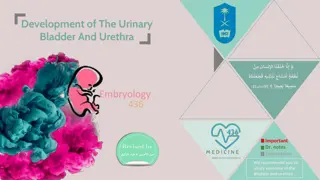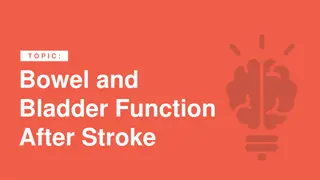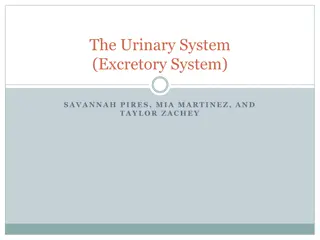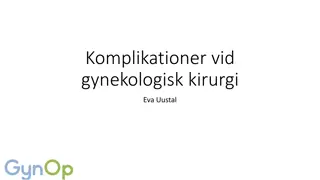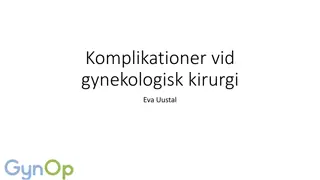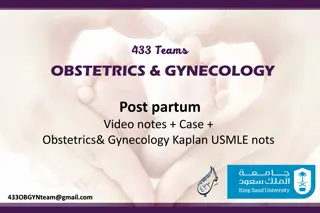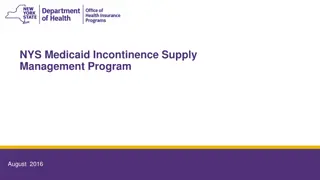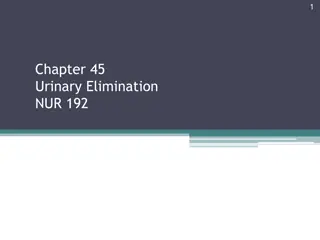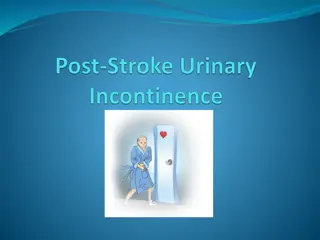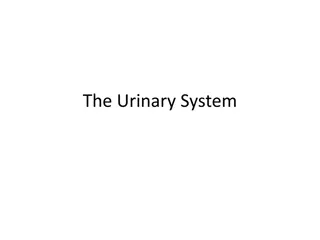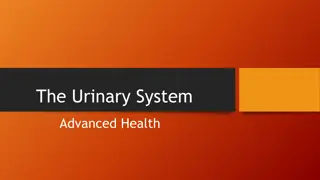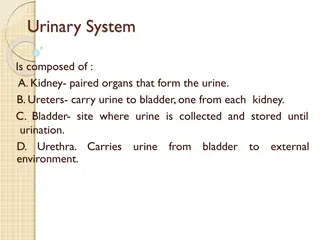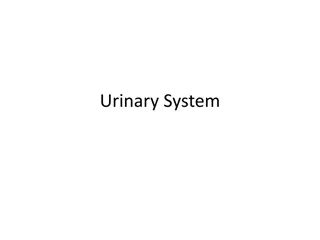Urinary Incontinence in Women: Prevalence, Implications, and Types
This informative content discusses the prevalence, implications, quality of life impact, differential diagnosis, reversible causes, and common types of urinary incontinence in women. It also highlights stress incontinence, urge incontinence, mixed overflow incontinence, and functional incontinence.
Download Presentation

Please find below an Image/Link to download the presentation.
The content on the website is provided AS IS for your information and personal use only. It may not be sold, licensed, or shared on other websites without obtaining consent from the author.If you encounter any issues during the download, it is possible that the publisher has removed the file from their server.
You are allowed to download the files provided on this website for personal or commercial use, subject to the condition that they are used lawfully. All files are the property of their respective owners.
The content on the website is provided AS IS for your information and personal use only. It may not be sold, licensed, or shared on other websites without obtaining consent from the author.
E N D
Presentation Transcript
Urinary Incontinence in Women Dr. Hazem Al-Mandeel Associate Professor Department of Obstetrics and Gynecology College of Medicine, King Saud University
Prevalence of Urinary Incontinence (UI) Prevalence of UI in Europe for women was 35% - 40.% Prevalence of UI in Canada was 50% Prevalence of UI in Far Asia was 22% - 50% Prevalence of UI in Saudi was 29% - 41% Prevalence of UI in Qatar was 20.6%
Implications of Incontinence o Medical: o Skin ulcers o Skin rashes o UTI o Falls o Social: o Loss of self-esteem o Social restriction o Depression o Economic: o Personal costs
Quality of Life Impact Impact on lifestyle and avoidance of activities Fear of losing bladder control Embarrassment Impact on relationships Increased dependence on caregivers Discomfort and skin irritation
Differential Dx of Urinary Incontinence in Women Genitourinary o Stress incontinence o Detrusor overactivity o Mixed incontinence o Urogenital Fistula o Urethral diverticulum Non-genitourinary Functional (Neurogenic, cognitive, psychological, physical impairment) Environmental Pharmacologic Metabolic
Reversible causes of incontinence (DIAPPERS) Delirium Urinary Tract Infection Atrophic vaginitis Pharmaceuticals Psychological Endocrine (D.M) Restricted mobility Stool impaction
Common Types of Urinary Incontinence Stress incontinence Urge incontinence Mixed Overflow incontinence Functional incontinence
Stress Incontinence: Involuntary loss of urine on effort or with physical exertion (causing increases in intra-abdominal pressure) Caused by pelvic floor damage/weakness or weak sphincter(s) Symptoms include loss of urine with cough, laugh, sneeze, running, lifting, walking Most common type in younger women (< 65 yrs.)
Risk factors for SUI Age Childbearing Obesity Increased intra-abdominal pressure Estrogen depletion (Menopause)
Urge Incontinence: Involuntary loss of urine associated with urgency (due to an involuntary detrusor contractions) Complaints of urgency, frequency, inability to reach the toilet in time, up a lot at night to use the toilet Multiple triggers
Causes of Urge Incontinence Neurogenic: CVAs Cerebral Tumors Cerebral Aneurysm Cerebral Hemorrhage Multiple Sclerosis Parkinson's Disease Spinal cord injury Idiopathic Other conditions UTI Atrophic Urethritis Urogenital Prolapse Fecal Impaction Bladder tumor Bladder stone
Mixed Incontinence: Combination of stress and urge incontinence Common presentation of mixed symptoms Urodynamics necessary to confirm
Stress : 49% Urge : 22% Mixed : 29%
Overflow Incontinence Large bladder volumes result in an intra- vesical pressure greater than the urethral closure pressure Causes: oAtonic Bladder oOutlet Obstruction
Chronic Urinary Retention: Outlet obstruction or bladder underactivity May be related to previous surgery, aging, development of bad bladder habits, or neurologic disorders Medication, such as antidepressants May present with symptoms of stress or urge incontinence, continuous leakage, or urinary tract infection
Functional and Transient Incontinence: Mostly in the elderly Urinary tract infection Restricted mobility Severe constipation Medication - diuretics, antipsychotics Psychological/cognitive deficiency
Diagnosis of Urinary Incontinence History Physical Voiding Diary PVR Urinalysis Urodynamics
Patient History: Focus on medical, neurologic, genitourinary history Review voiding patterns/fluid intake Voiding diary Review medications Explore symptoms (duration, most bothersome, frequency, precipitants) Assess mental status and mobility
Symptoms: Frequency Nocturia Dysuria Incomplete emptying Incontinence Urgency Recurrent infections Dyspareunia Prolapse
Physical Examination: General examination Edema, neurologic abnormalities, mobility, cognition, dexterity Abdominal examination Pelvic and rectal exam - women Examination of back and lower limbs Observe urine loss with cough
Urinalysis: Conditions associated with overactive bladder Hematuria Pyuria Bacteriuria Glucosuria Proteinuria Urine culture
Postvoid Residual Volume (PVR): If clinically indicated accurate PVR can be done by Catheterization Ultrasound PVR of <50 ml is considered adequate, repetitive PVR >200 ml is considered inadequate Use clinical judgment when interpreting PVR results in the intermediate range (50-199 ml)
Treatment : Stress Incontinence Nonsurgical Pelvic floor muscle training (Kegel) Biofeedback Electrical stimulation Pessaries Medications Surgical : recreating urethral support Abdominal Vaginal
Kegel Exercise 10 20 repetitions three times per day Hold contraction for 5 to 10 seconds A set can be done to suppress urgency Results take 6 8 weeks to manifest NOT to be done while voiding Improvement & cure rates as high as 60%
Treatments : Surgical Abdominal approaches Open retropubic colposuspension (Burch) Pubo-vaginal sling Midurethral tape procedure (e.g. TVT, TOT,TVTO, Mini Slings) Periurethral Bulking Agents
Treatment Modalities for OAB Behavioural Modification Drug Treatment Neuromodulation (for refractory cases) Surgical Treatment (for refractory cases)
Behavioral Modification Bladder retraining Education Behavioral Modification Pelvic Floor muscle exercises Toileting programs Lifestyle changes
Bladder Retraining Bladder Drill: Increase intervals between voids Aim for q2-3h Timed Voids (spinal cord) Voiding times pre-selected e.g.. q2h Interval based on avoiding leakage Prompted Voids Fixed time interval between voids Third party prompt Interval based on avoiding leakage
Lifestyle Interventions Elimination of bladder irritants Manage fluid intake Cessation of smoking Weight reduction Bowel regulations Use diuretics judiciously (not before bed) Reduce physical barriers to toilet (use bedside commode)
Drug Treatment of OAB Drug Level of evidence Antimuscarinics Tolterodine Trospium Darifenacin Solifenacin Propantheline 1 A 1 A 1 A 1 A 2 B Drugs with mixed actions Oxybutynin Propiverine Flavoxate Dicyclomine 1 A 1 A 2 D 3 C Antidepressants Imipramine 3 C Vasopressin analogues Desmopressin International Consultation on Incontinence, 2004 1 A
Treatment: Overflow Incontinence Self Intermittent Catheterization ?Alpha Blockers ? Cholinergic Agents
Treatment: Mixed Incontinence Treat the component which is most troubling to the patient
